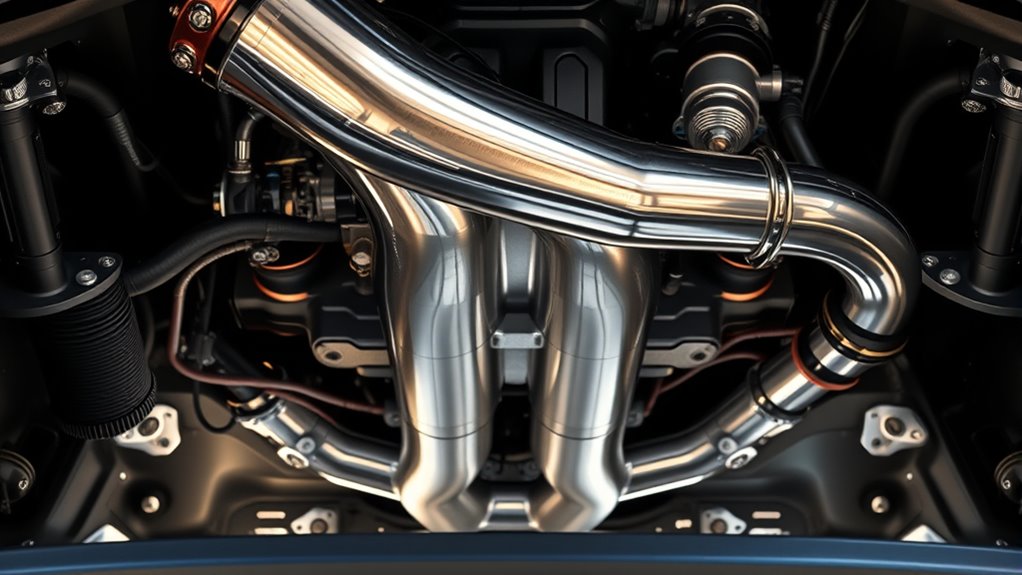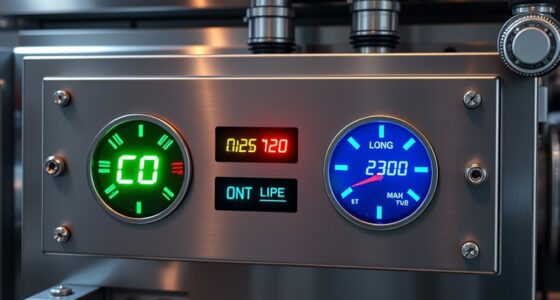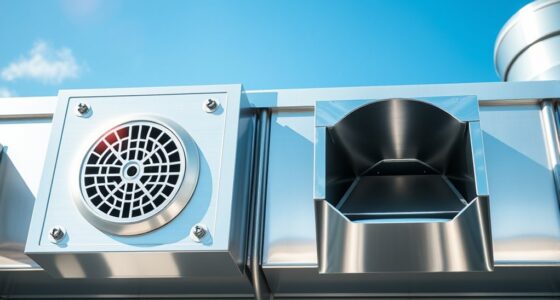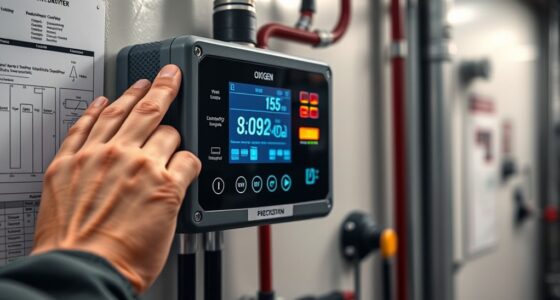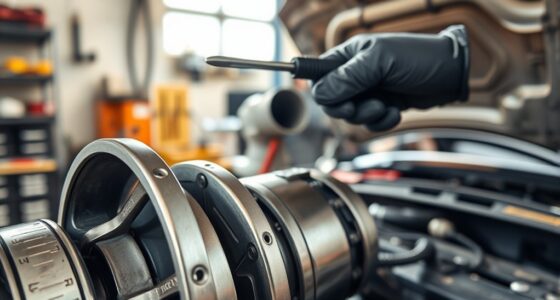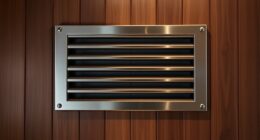To become confident in ventilation choices, understand that fresh air intake systems actively bring in outdoor air through filters, improving indoor air quality, while exhaust systems remove stale air, pollutants, and humidity. Both work together to create a healthy environment, but your needs depend on your space and climate. Balancing these systems optimizes air quality and efficiency. Keep exploring to discover how to choose and optimize the right solution for your home.
Key Takeaways
- Fresh air intake systems introduce outdoor air, improving indoor air quality and maintaining proper humidity and temperature levels.
- Exhaust systems remove indoor pollutants, stale air, and moisture, preventing buildup and enhancing overall air quality.
- Balancing both intake and exhaust systems ensures optimal airflow, energy efficiency, and a healthy indoor environment.
- Proper design and maintenance of each system prevent issues like drafts, backpressure, and system inefficiencies.
- Combining natural passive solutions with mechanical systems provides flexible, effective ventilation tailored to specific needs.
Understanding the Basics of Indoor Air Quality
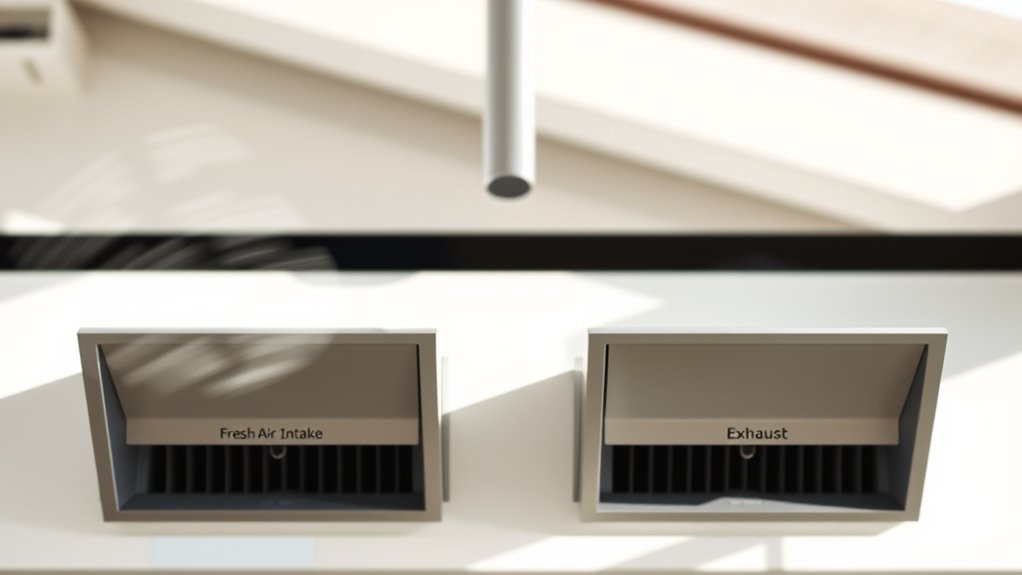
Understanding indoor air quality is vital because the air inside your home can be more polluted than the outdoor air you breathe. Indoor pollution comes from everyday activities, cleaning products, and even building materials. Poor air quality can cause health issues like allergies, asthma, and fatigue. Air purification plays a key role in reducing airborne contaminants and improving overall comfort. By filtering out dust, pet dander, mold spores, and volatile chemicals, air purification systems help maintain healthier indoor environments. Regular maintenance, such as filter replacement every 6-12 months, is essential to ensure continued effectiveness. You should be aware of how indoor pollution builds up and impacts your health. HEPA filtration is particularly effective at capturing small particles like allergens and pollutants. Regular ventilation, combined with effective air purification, ensures fresh, clean air circulates throughout your home. Taking these steps helps you breathe easier and creates a safer living space for everyone.
What Is a Fresh Air Intake System?
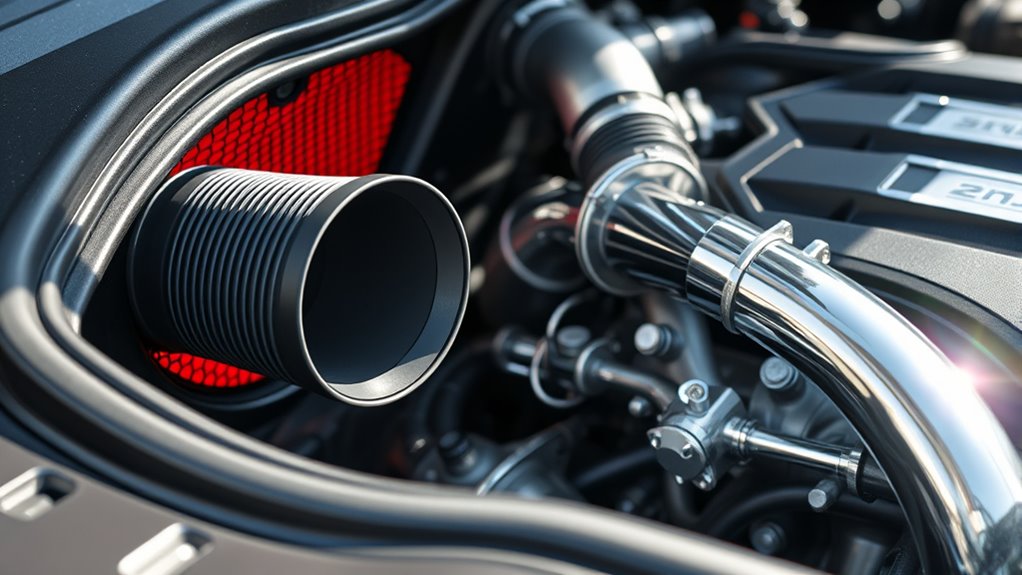
A fresh air intake system actively brings outdoor air into your home, helping to improve indoor air quality by reducing pollutants and replenishing oxygen levels. It works by drawing in outside air through a designated vent, which often includes an air filter to trap dust, pollen, and other particles. Regular air filter maintenance is essential to keep airflow dynamics ideal and prevent debris buildup that could hinder ventilation. This system guarantees a steady exchange of fresh air, balancing indoor humidity and temperature. By controlling airflow, it helps reduce indoor pollutants and stale air. Understanding how your fresh air intake functions allows you to better maintain it, ensuring healthier indoor environments and more efficient air circulation overall. Additionally, incorporating proper filtration technology can further enhance the system’s ability to maintain optimal air quality.
How Does an Exhaust System Function?
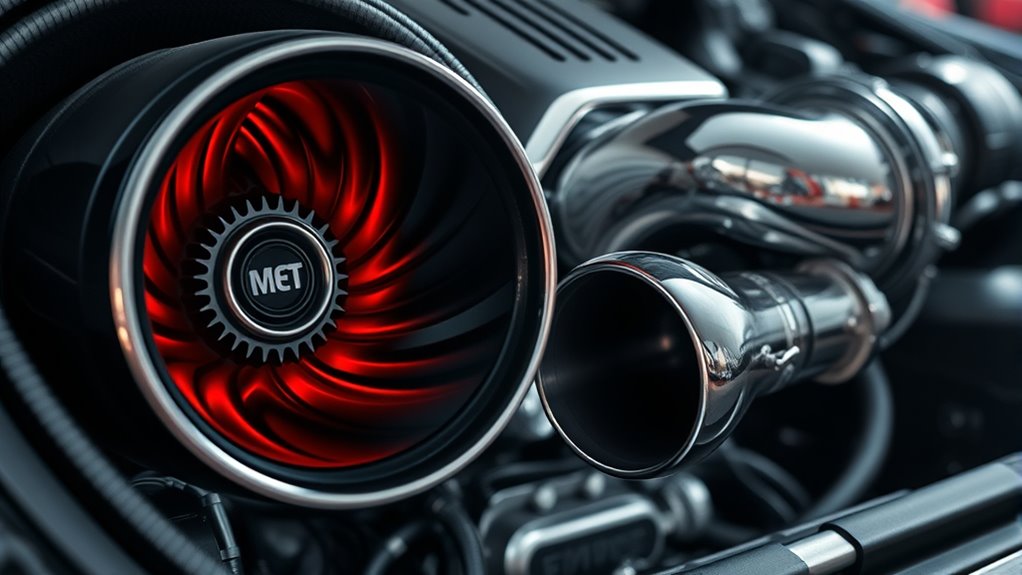
Your exhaust system directs gases from the engine through a specific flow path, ensuring safe and efficient removal. It uses a catalyst to reduce harmful emissions and a muffler to minimize noise. This setup directly impacts your vehicle’s performance and overall efficiency. Additionally, proper appliance maintenance can help ensure your vehicle’s exhaust components remain in optimal condition.
Gases Flow Path
Gases produced during combustion follow a specific path through the exhaust system, starting from the engine cylinders and moving outward. As the gases flow, airflow dynamics play an essential role in efficiently directing pollutants away from the engine. The design of the exhaust system ensures smooth, continuous movement, minimizing backpressure and optimizing engine performance. During this process, pollutant dispersion occurs, helping to break down harmful emissions before they exit the tailpipe. The gases pass through various components, such as the manifold and pipes, which shape their flow path. Proper routing and design enhance not only exhaust efficiency but also reduce harmful emissions, guaranteeing cleaner operation. Understanding this flow path helps you appreciate how each part works together to keep your vehicle running smoothly and environmentally friendly. Additionally, the flow of gases is influenced by airflow dynamics, which plays a crucial role in maintaining engine efficiency and reducing emissions.
Catalyst and Muffler Role
The catalyst and muffler work together to reduce harmful emissions and improve your vehicle’s sound and performance. The catalyst function is to convert toxic gases like carbon monoxide, hydrocarbons, and nitrogen oxides into less harmful substances such as carbon dioxide and water. It’s crucial for meeting environmental standards and keeping emissions in check. Additionally, advancements in emission control technology continue to enhance the effectiveness of catalytic converters. Meanwhile, the muffler purpose is to quiet the engine’s noise by dampening sound waves produced during exhaust flow. It contains chambers and perforated tubes that absorb and cancel noise, making your ride smoother and quieter. Together, these components ensure your exhaust system not only minimizes pollution but also provides a more comfortable driving experience. Their combined efforts are essential for efficient, eco-friendly vehicle operation.
Performance Impact
An exhaust system plays a critical role in enhancing your vehicle’s performance by efficiently directing and managing exhaust flow. It reduces backpressure, allowing the engine to breathe better, which boosts power and acceleration. Proper air filtration within the exhaust system prevents harmful particles from circulating, protecting engine components. Humidity control is also essential; managing moisture levels prevents rust and corrosion, maintaining ideal function. A well-designed exhaust system improves fuel efficiency by ensuring gases exit smoothly. Plus, it minimizes harmful emissions, making your vehicle more environmentally friendly. Additionally, regular inspection of components like the exhaust pipes can prevent leaks and maintain optimal performance. Overall, the performance impact of an exhaust system hinges on its ability to maximize airflow, filter air effectively, and control humidity, all of which contribute to a more responsive, durable, and efficient vehicle.
Comparing the Benefits of Intake and Exhaust Systems
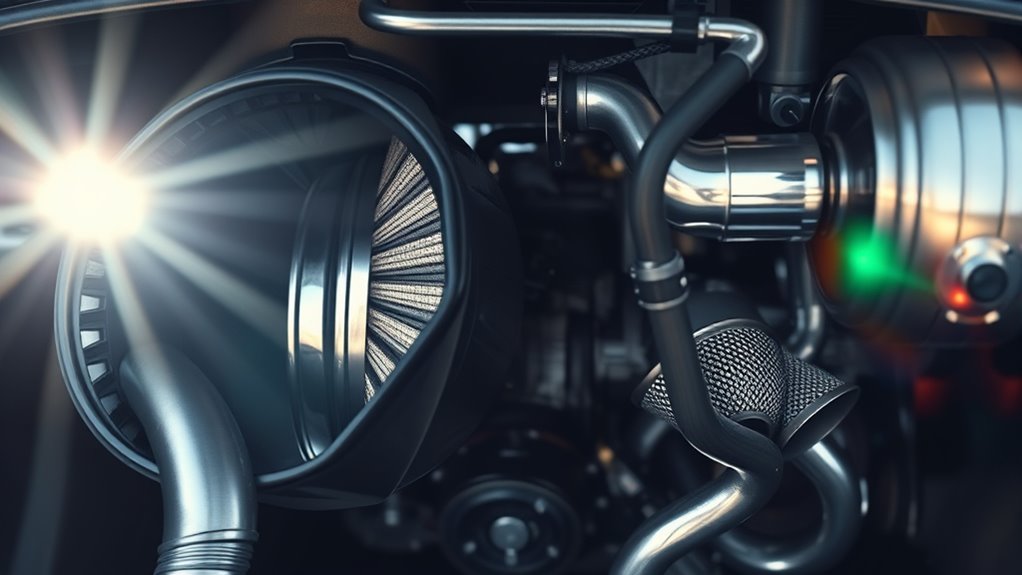
While both intake and exhaust systems play essential roles in vehicle performance, understanding their individual benefits can help you make smarter choices for your car’s setup. An effective intake system enhances air filtration, ensuring clean air reaches the engine, which improves efficiency and longevity. It also benefits from smart ventilation design, allowing ideal airflow that boosts power and throttle response. Conversely, exhaust systems are designed to reduce backpressure and improve the removal of pollutants, leading to better fuel economy and lower emissions. They also influence sound and overall engine performance. Comparing these benefits, you realize that a well-designed intake maximizes airflow and filtration, while a quality exhaust optimizes exhaust flow and emissions. Balancing both is key to achieving excellent vehicle performance and efficiency. Additionally, integrating performance upgrades like cold air intakes and exhaust systems can further enhance your vehicle’s tuning potential.
Common Types of Fresh Air Intake and Exhaust Solutions

There are several common solutions for fresh air intake and exhaust that you can consider. Passive ventilation options use natural airflow, while mechanical exhaust systems rely on fans to remove stale air. Hybrid methods combine both approaches to optimize indoor air quality and energy efficiency. Incorporating sound effects libraries can enhance the auditory experience of ventilation systems in creative projects.
Passive Ventilation Options
Passive ventilation options provide a straightforward way to improve indoor air quality without relying on mechanical systems. They enhance ventilation design by utilizing natural forces to circulate fresh air. You can choose from several effective solutions:
- Vents and louvered openings that allow air to flow naturally in and out of your space.
- Operable windows positioned strategically to promote cross-ventilation and maximize airflow.
- Air bricks and vents integrated into walls or floors to facilitate continuous passive airflow.
- Incorporating headphones can help you enjoy your indoor environment quietly while monitoring airflow or communicating with others remotely. These options are simple to implement and require minimal maintenance, making them ideal for improving air quality efficiently. By understanding passive ventilation, you can create a healthier indoor environment while reducing energy costs. It’s all about optimizing natural airflow to support your ventilation design goals.
Mechanical Exhaust Systems
Mechanical exhaust systems are essential for controlling indoor air quality by actively removing stale air and pollutants from your space. They work with fans and ducts to exhaust contaminated air, improving comfort and health. Many systems incorporate air filtration to trap dust, allergens, and other particles before air is expelled, ensuring cleaner indoor air. Noise reduction features are also common, helping to minimize sound from the exhaust fans so that they don’t disrupt your environment. Options include wall-mounted exhaust fans, ceiling-mounted systems, and inline fans, giving you flexibility based on your space’s needs. Properly designed mechanical exhaust systems provide reliable ventilation, maintain air quality, and operate quietly, making your indoor environment healthier and more comfortable. Utilizing ventilation system options can further optimize indoor air quality and energy efficiency.
Hybrid Ventilation Methods
Hybrid ventilation methods combine the strengths of natural and mechanical systems to optimize indoor air quality and energy efficiency. By integrating these approaches, you can influence airflow patterns to enhance ventilation efficiency while reducing energy costs. These systems adapt to your building’s needs, balancing fresh air intake and exhaust based on real-time conditions.
Key solutions include:
- Automated control of windows and vents for natural airflow
- Mechanical systems that supplement natural ventilation when needed
- Sensors that monitor air quality to optimize airflow patterns
This combination guarantees you get consistent, effective ventilation without over-relying on one method. Hybrid systems offer smarter airflow management, reducing drafts and stale air while maintaining energy savings.
Factors to Consider When Choosing Between Them
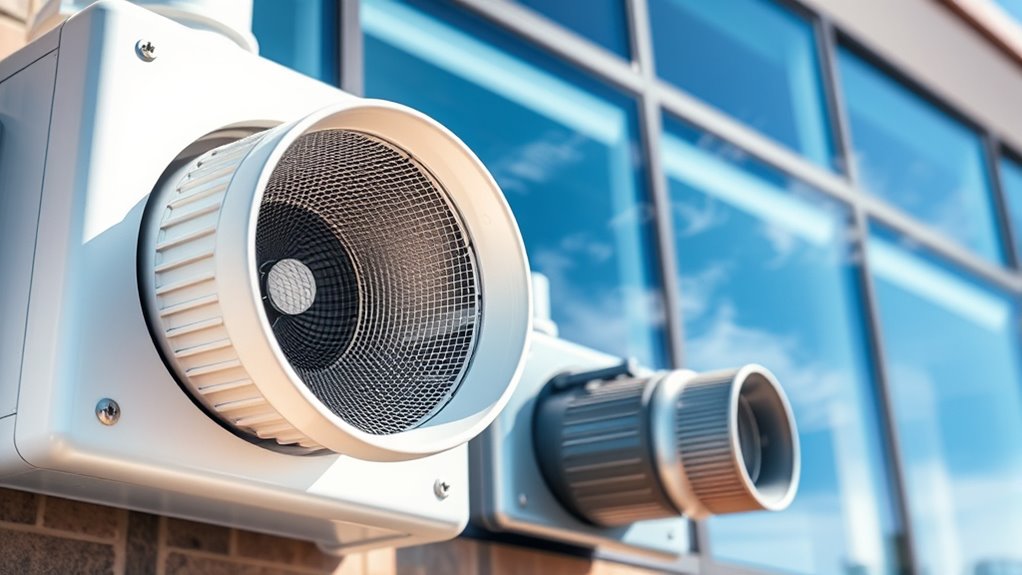
When selecting between fresh air intake and exhaust systems, you need to take into account several key factors to guarantee ideal indoor air quality and energy efficiency. One vital factor is airflow patterns—understanding how air moves within your space helps determine which system will best promote proper ventilation without creating drafts or stagnant zones. You should also consider energy efficiency, as some systems consume less power while maintaining effective ventilation. The layout of your building, the size of the space, and its usage influence your choice. Additionally, local climate conditions and noise levels may impact your decision. Balancing these factors ensures you choose a solution that maintains healthy indoor air while optimizing energy consumption.
Tips for Optimizing Your Indoor Air Ventilation

To maximize your indoor air ventilation, start by guaranteeing proper airflow distribution throughout your space. Good airflow boosts air quality and enhances ventilation efficiency. You can achieve this by:
- Using ceiling fans or oscillating fans to circulate air evenly
- Installing vents or registers in strategic locations to promote fresh air intake and exhaust
- Regularly inspecting and maintaining filters and vents to prevent blockages and ensure smooth airflow
Implementing these tips helps prevent stale air buildup and reduces indoor pollutants. Proper ventilation keeps the air fresh and maintains a healthier environment. Focus on creating a balanced system where fresh air enters while stale air exits efficiently. With careful adjustments, you’ll optimize your indoor air quality and enjoy a more comfortable, breathable space.
Frequently Asked Questions
How Do I Know if My Home Needs Better Ventilation?
If you notice stale air, persistent odors, or high indoor humidity, your home likely needs better ventilation. Poor air quality can cause allergies or respiratory issues, so consider improving airflow. You might also see condensation or mold growth, indicating inadequate ventilation. Ensuring fresh air exchange helps maintain healthy indoor humidity levels and improves air quality, making your home more comfortable and safe.
Can Improper Ventilation Cause Health Issues?
Did you know indoor pollutants can be up to five times higher than outdoor air? Improper ventilation definitely causes health issues by trapping pollutants, mold, and allergens, which can lead to respiratory problems, allergies, or even asthma. Poor air quality affects your well-being daily. Ensuring proper ventilation helps reduce indoor pollutants, improves air quality, and keeps your home healthier. Don’t ignore signs—good airflow is essential for your health and comfort.
What Are the Costs Associated With Installing These Systems?
The cost comparison for installing fresh air intake or exhaust systems varies based on size and complexity. Generally, installation expenses include equipment, labor, and maintenance. You might spend anywhere from a few hundred to several thousand dollars. Fresh air intake systems tend to be more expensive initially but improve air quality, while exhaust systems are usually more affordable. Consider your needs and budget to choose the right system for your space.
How Often Should Ventilation Systems Be Maintained?
You should maintain your ventilation system every 6 to 12 months to guarantee excellent air quality and extend its system lifespan. Regular inspections, filter replacements, and cleaning help prevent dust buildup and mold growth. Neglecting maintenance can reduce efficiency, compromise air quality, and shorten the system’s lifespan. By staying consistent with upkeep, you ensure your system continues to provide fresh air and maintains a healthy indoor environment.
Are There Energy-Efficient Options for Fresh Air Intake and Exhaust?
Did you know that energy-efficient ventilation options can substantially boost your home’s air quality and save you money? You should consider systems like heat recovery ventilators (HRVs) or energy recovery ventilators (ERVs), which improve air quality while reducing energy use. These options are designed to optimize fresh air intake and exhaust, ensuring you get cleaner air without skyrocketing energy bills. Investing in such technology makes your home healthier and more sustainable.
Conclusion
Choosing between fresh air intake and exhaust systems might seem overwhelming, but imagine breathing in crisp, clean air every day, feeling more energized and healthier. Even if you worry about installation hassle or costs, think of it as investing in your well-being—like opening a window on a breezy day. With the right system in place, you’ll enjoy consistently fresh air, making your space a sanctuary of comfort and importance.
